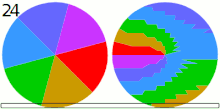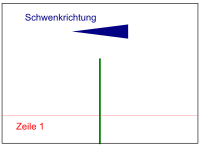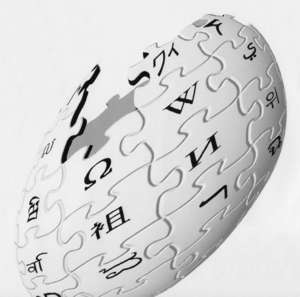Rolling shutter effect
The rolling shutter effect (for example: “rolling shutter”) is a positional error that can occur in photos or video recordings of moving objects.
Explanation
At first it seems natural that the exposure of all points of the light-sensitive element (film or sensor) of a camera begins at exactly the same point in time. However, there are cameras for which this does not apply to the entire surface due to their design; Rather, one has to imagine a "line of simultaneous exposure starts " that wanders over the element either line by line or column by column, for which it takes a short, but not negligible time.
As long as the subject is still, all image points are exposed at their correct position in such cameras , regardless of when the corresponding points were exposed. If, however, pictures of a moving subject, or with a moving camera, are taken with consecutively exposed lines, objects are shown at their current location - and since the mapping is done line by line, the object has already moved so far from one line to the next that when it is combined of all lines an object is displayed that was not shown as a whole at once, but line by line at different times. A straight line of the subject can be shown crooked or distorted when the camera is panned or a moving subject (corresponding to the successive individual lines).
The rolling shutter effect occurs when:
- Focal- plane cameras . The effect is particularly evident when the subject is illuminated with a stroboscope .
- Digital cameras with image converters in CMOS sensor technology. These sensors read the image line by line or column by column. This takes a comparatively long time, especially with professional sensors. If the affected (mostly mirrorless) system cameras use an electronic shutter instead of a focal plane shutter - in the absence of one or optionally for noise reduction - this is correspondingly slow - even slower than the focal plane shutter. Problems are then already caused by certain common artificial light sources and photography with flash , which is then either not possible at all or only possible with a long flash sync speed that is even unusable during the day .
High-resolution camcorders and video-compatible digital cameras are increasingly being equipped with CMOS image converters, which replace the CCD sensors that were previously used . The CMOS image converter can cause the rolling shutter effect to occur in these devices. As in photography , this effect occurs through diagonal distortion when recording fast-moving subjects; in addition, stronger vibrations of the recording device, such as those that occur when taking pictures from a vehicle, lead to a strong distortion of the entire image, which causes the recordings may become unusable.
- Examples of rolling shutter recordings
Avoidance
The rolling shutter effect can be avoided with so-called global shutter CMOS sensors, which do not record the image in rows and columns, but rather completely. Due to their different mode of operation, CCD sensors do not show a rolling shutter effect.
Examples for illustration
Shooting stars

Shooting stars can be taken in the dark during a long exposure . With many CMOS image sensors, these exposures, which usually last several seconds, are recorded at several images per second, which are then added to form a total recording. If a single readout run by the image sensor is shorter than the duration of the falling star, only the brightly shining current location of the meteorite is recorded. All other pixels along the light trail only ever capture the comparatively weak afterglow of the falling star.
simulation
In the following images, a camera panning to the left (the subject moves to the right) is shown schematically when a vertical, green line is recorded with three lines following each other from bottom to top:
With a higher number of lines, the steps and jumps are correspondingly smaller, so that in the borderline case a continuous sloping line would arise.
Flatbed scanner
The following two images were taken one after the other with the same flatbed scanner with line sensor . In the first picture, the paper template was motionless, in the second picture the template was moved at a constant speed perpendicular to the direction of movement of the scan unit, so that the rolling shutter effect becomes visible.
Individual evidence
- ↑ Hands-on with new Sigma 'fp' - a compact, full-frame, L-mount mirrorless camera , DPreview, July 11, 2019.
- ↑ Advantages and disadvantages of electronic, slot and central locking , digitalcamera.de, October 17, 2016.
Web links
- Sample video: Rolling shutter effect on an aircraft propeller - Spiegel Online
- High-speed video examples and explanations of the focal plane shutter and rolling shutter effect (English)
- Why Do Cameras Do This? (Rolling Shutter Explained) - Simulation of the rolling shutter effect from high-speed recordings










